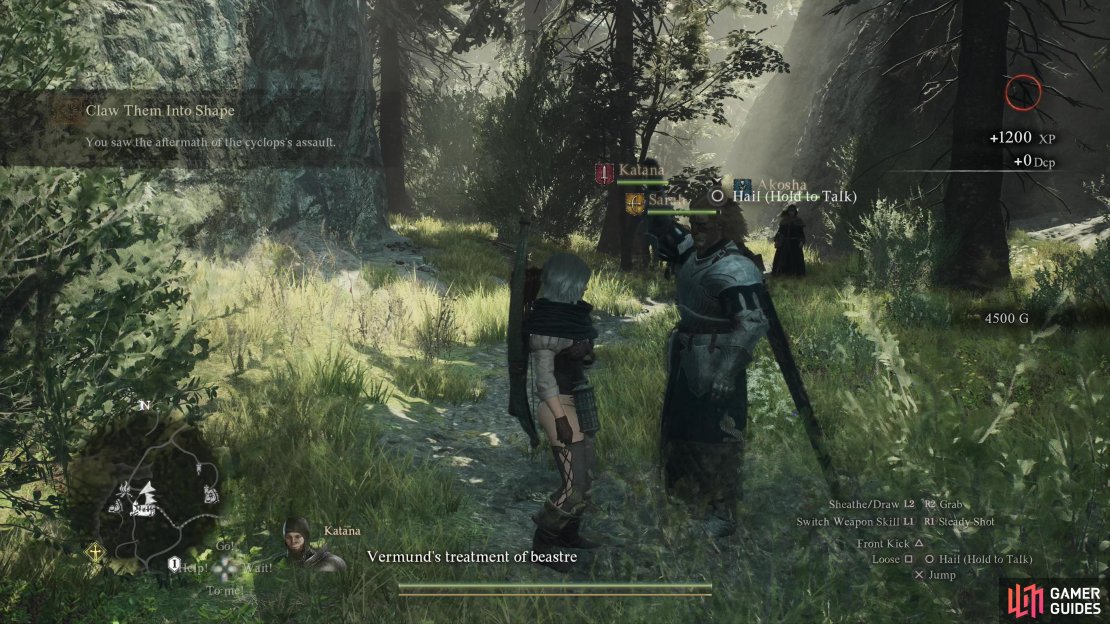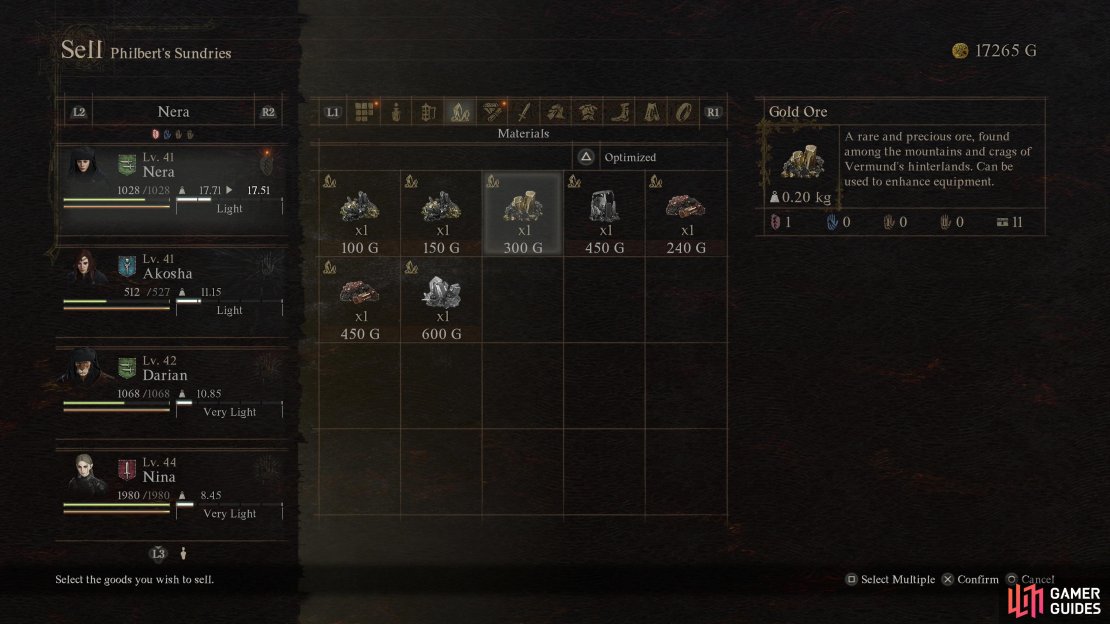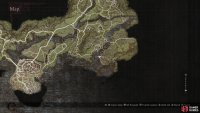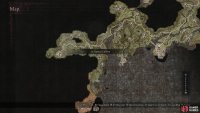Money is a vitally important resource in Dragon’s Dogma 2, especially in the early game, where it can be fairly easy to sprint ahead to new towns and gain access to new weapons… with significant stat boosts matched by their ever-inflating sticker prices. We all love to pretend to enjoy a good challenge, but all the better if that challenge is backed up by a bit of RPG shenanigans… plus playing dress-up in Dragon’s Dogma is a much-appreciated pastime. You’ll need gold to get new gear on the regular, fast travel, rest at inns, buy real estate, and more, and this page will help you find ways to earn money fast early in Dragon’s Dogma 2.
How to Farm Gold in Dragon’s Dogma 2¶
At a glance, the economy in Dragon’s Dogma 2 might seem fairly balanced, and casual players will generally see their coin purses getting fatter by, shockingly, just playing the game. You’ll generally earn gold via three sources: plundering the smote remains of your enemies, completing quests, and selling items. In addition, you can sometimes find the odd windfall of cash in treasure chests and by digging through bone piles and debris piles, but neither are arguably reliable enough sources of money to satiate any short-term cash needs you have.
Generally, the best way to earn money in the long term is to just play the game. The more you’re exploring, fighting, and looting, the richer you’ll get. It’s perhaps not a terribly satisfying answer, but it’s true, although there are some things you can do to expedite the process by targeting particular sources of wealth.
Completing quests is a fine way to earn some cash, but not a repeatable source of income.
Earning Gold from Quests¶
Pretty straightfoward, if you complete a quest, you’ll get some cash. Often thousands of gold per quest even early in Venworth, with repeatable culling and escort quests offering just over 1,000G. It’s not a bad way to fill your coin purse, but some quests are quite lengthy for their rewards offered and are, of course, finite. On the other hand, you’ll often end up fighting monsters and/or exploring while completing said quests, which are other, less fickle ways of earning cash.
Large monster materials are also fairly valuable - becoming a big game hunter is one of the best ways to earn money.
Earning Gold from Defeating Enemies¶
You see a monster, you kill it. Then you loot it, and its lair, if applicable. Most of the time you’ll get some material with dubious apparent value, but rest assured, materials gained from monsters can be used in both crafting and as sale fodder. Naturally more powerful enemies tend to drop more valuable materials, although the correlation isn’t perfect and there are outliers. Below you’ll find a list of some early game materials you can claim from large enemies in Dragon’s Dogma 2 and their sale values:
| Material | Source | Value |
|---|---|---|
| Rugged Bone | Cyclops | 300 |
| Cursed Dullahan Bone | Dullahan | 900 |
| Minotaur Horn | Minotaur | 300 |
| Griffin Pinion | Griffin | 1200 |
| Ogre Spur | Ogre | 300 |
| Great Griffin Claw | Griffin | 600 |
| Misshapen Eye | Cyclops | 800 |
| Freakish Mane | Chimera | 900 |
| Dappled Ore | Golem | 600 |
| Magick Medal | Golem | 1200 |
| Black Crystal | Wight | 480 |
| Wyrmslife Crystal | Drake | 1500 |
Of course, value alone doesn’t say much about how farmable these materials are. You’ll typically get a few of most of these materials each time you defeat its host monster (with Black Crystals, Griffin Pinions, and Misshapen Eyes being notably rarer), but availability is the best ability. Cyclopes, Minotaurs, and Ogres are all abundant early-game, with the others generally being less abundant, although all have static spawns you can reach and without too much hassle. It’s also generally easier to farm terrestrial foes as they can’t fly away when pressured, thus depriving you of your prize.
If you wanted to farm any of these enemies for their materials, however, the most lucrative target is the Golem. These enemies are some of the more challenging foes you’ll face early on and probably aren’t suitable prey for weaker parties, but they do drop numerous Magick Medals when defeated. An average Golem may yield six Magick Medals, each selling for 1,200G, or a grand total of 7,200G per kill. You can encounter one of these monstrosities in the Guerco Cavern, which is an interesting coincidence for reasons that will be expanded upon shortly.
Big game hunting is all well and good, but most enemies you fight won’t be heavyweights. Fortunately, the small guys have drops, too, and while they’re not as lucrative, generally, they’re a lot more common. Their value generally ranges from 42G on the low end (Beast-Skin and Rabbit Pelts) to 300G on the high end (Putrid Gold Tooth). Again, there’s no correlation between the danger of the enemy, its abundance, or the ease with which it can be farmed and the value of its materials, which aren’t guaranteed drops in any case. You can absolutely try to focus your attention on one type of enemy and farm them for what you need; Zombies drop Putrid Gold Tooth materials, but only spawn at night and are resistant to physical damage, which you can offset with skills or spells that deal fire damage.
As a general rule most enemies respawn after a day, and resting seems to be a surefire way to respawn most foes, so finding preferred targets near a place you can rest for free or at least cheaply is recommended. Farming small enemies is best done on a macro scale, however, or not at all - just be aware that all of the trash mobs you kill drop valuable loot, too, and cashing in some Slate-Colored Horns (Hobgoblins) can give you some much-needed cash in a pinch.
Finally, some enemies - smaller humanoids, mostly - can just drop lump sums of gold. This includes bandits, goblins, and hobgoblins and the money they drop generally ranges from 100G to 400G, and unlike with materials in this case there is a correlation between the difficulty of the enemy and the gold they can drop. Goblins drop less than Hobgoblins, and more powerful variants of each yield more money still. Sometimes it’s nice not to have to think about selling materials and just add the coins to your purse, you know?
(1 of 3) Selling ore is a fine way to make money.
Earring Gold by Selling Ore¶
Enemies aren’t your only source of materials. Throughout the world, you’ll find all sorts of interesting creatures and objects, namely grazing animals (boars, deer, rabbits, oxen) fruit, herbs, ore, fishing holes, and other naturally occurring treasures. You’ll find these as you explore, and they can be harvested easily enough. Their locations are generally static, too, so once you find a particular source for any of these resources, you can farm them when they respawn (resting usually does the trick). Their value is variable, and many of these materials can be combined into other items, which may sell for more or less than their constituent parts, but the extra gold is rarely worth the hassle.
The more you hunt, mine, fish, and harvest, the wealthier you’ll be, but when it comes to just making money, ore is your best bet. Ore seams can be found on natural stone walls throughout the game, but with a few exceptions, your best sources are caves or mines - Trevo Mine and Stormwind Cave being both decent early-game options. Rarer ore is more valuable than common ore, and rarity is correlated with region, which is to say game progression, and hence, enemy difficulty. You’ll typically only find copper, silver, and gold ore, which still sell for a bit, but not really much more than most common materials do. Once you start getting into rarer ores, however, the prices get more respectable:
| Ore | Value |
|---|---|
| Copper Ore | 100 |
| Silver Ore | 150 |
| Gold Ore | 300 |
| Fuligin Ore | 450 |
| Southron Iron | 240 |
| Copperstone | 450 |
| Whitecobble | 600 |
Even common ore will net you 100G, and you don’t really need that much of it for upgrades, so if you see a vein, go mine it. You’ll typically only get 1-3 ore from a seam, but some caverns or cliff faces can have several seams in them, which could allow you to score a good bit of ore in short order.
(1 of 4) Guerco Cavern can be found between Harve and the Checkpoint Rest Town in Vermund.
Farming Gold at Guerco Cavern¶
You don’t want to just focus on one source of profit, you’d ideally want to do a little of everything - defeat small enemies, defeat large enemies, mine ore, and then sell the materials gained from the lot. There are numerous places where you can do this - caves aren’t just fine spots to search for ore, but they’re often monster dens, as well. One cave in particular has just about everything you’d want: the Geurco Cavern (https://www.gamerguides.com/admincp/map/246/markers#70922).
This doesn’t really count as a “low-level” area, as the enemies within are quite fierce, and it’s a secret shortcut to Battahl, a region that’s just more dangerous in general compared to Vermund. After cutting your teeth and building up wealth in Vermund, however, you can attempt to sneak past the Drake guarding the entrance. You’ll still have to contend with Hobgoblins and other monsters, the most notable being a Golem and a Chimera, but the materials you can harvest can be quite valuable. The Golem’s Magick Medals should earn you 6,000G - 7,200G alone and the Chimera’s Freakish Manes and the numerous ore veins near it should collectively add 4000G+.











No Comments